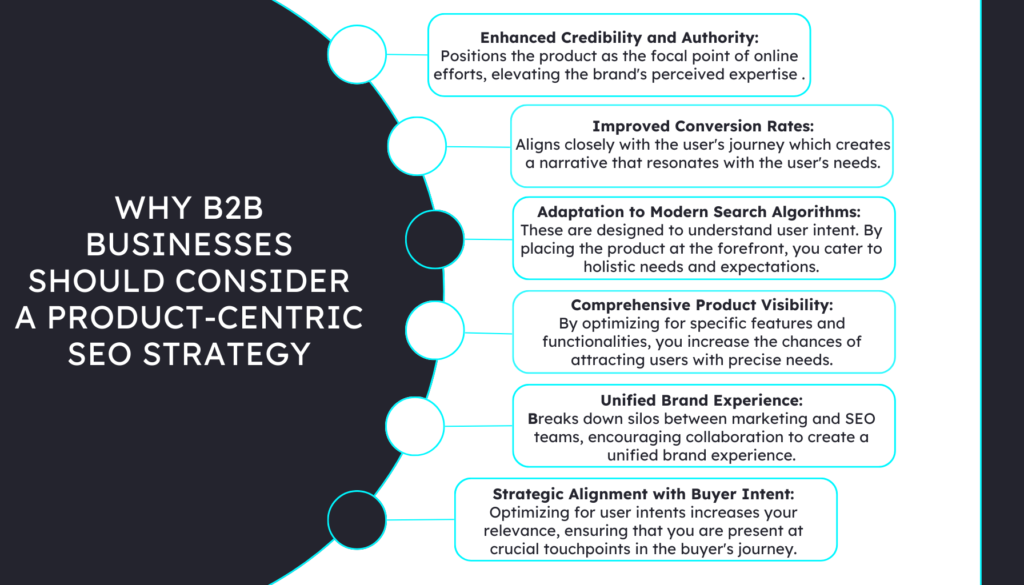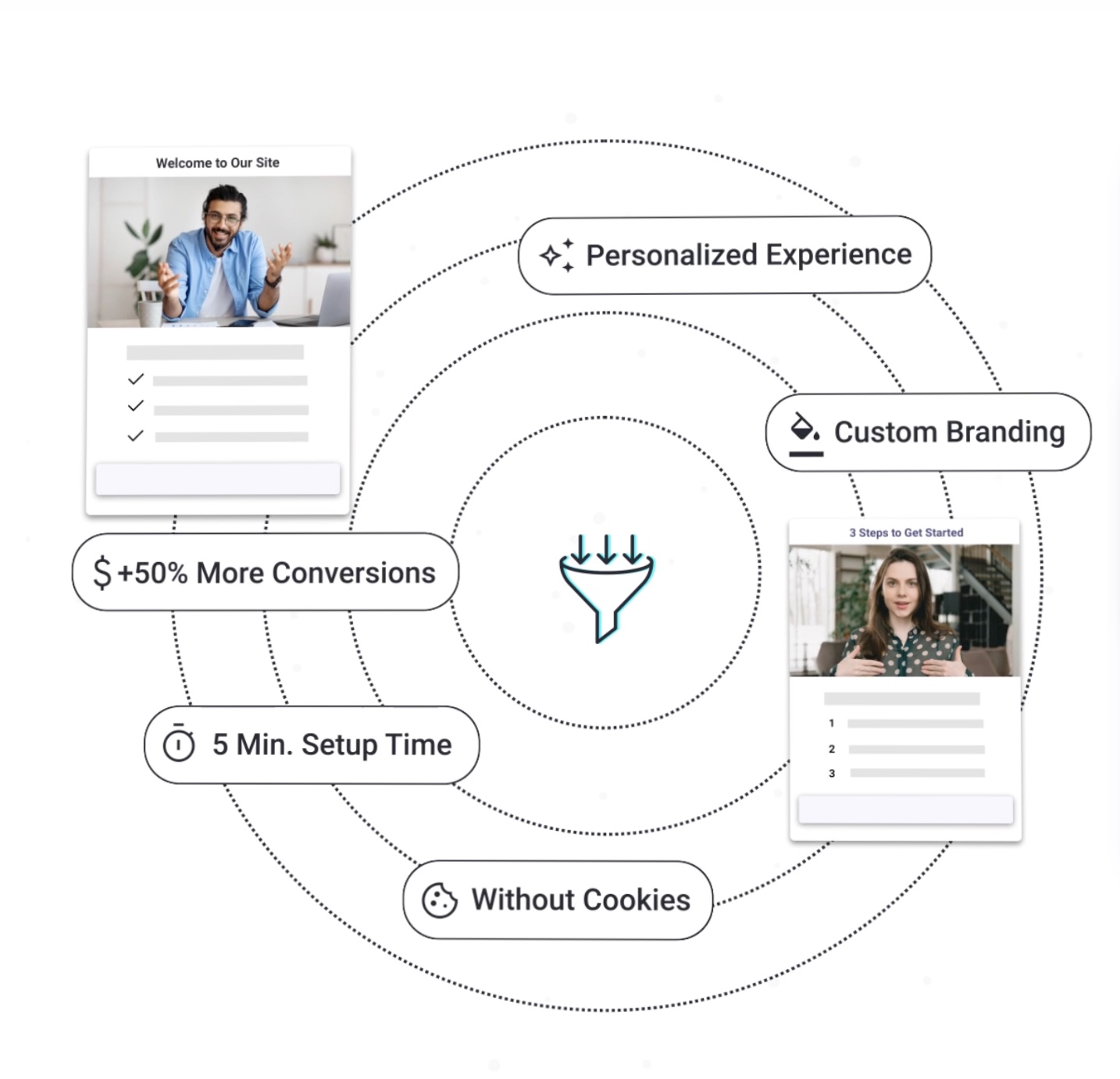How to Leverage Product-Led SEO for B2B Marketing


Product-Led SEO is a dynamic approach to search engine optimization that places the product or service at the forefront of the strategy. It goes beyond the traditional focus on keywords and backlinks, emphasizing the seamless integration of the product within the online user experience.
In this blog post, we’ll explore how this strategy, coined and popularized by Eli Schwartz, is creating new growth opportunities for marketers, especially in the B2B realm.
Table of Contents
The Key Principles of Product-Led SEO
- User-Centric Optimization: Product-Led SEO prioritizes the needs and preferences of the target audience. By understanding user intent and behavior, you can tailor your SEO strategies to provide a more personalized and relevant experience for potential customers.
- Comprehensive Product Visibility: It involves optimizing not just for generic product categories but for specific product features and functionalities. This comprehensive approach ensures that every aspect of the product is visible to search engines, increasing the likelihood of attracting users interested in specific attributes.
- Integrated Marketing and SEO: Product-Led SEO breaks down the silos between marketing and SEO teams. It encourages collaboration to ensure that marketing messages align seamlessly with the product’s online presence, creating a unified and coherent brand experience.
Why B2B Businesses Should Consider a Product-Centric SEO Strategy
A product-centric SEO strategy is not just a tactical shift but a holistic approach that empowers B2B businesses to thrive in the digital landscape. By making the product the focal point of SEO efforts, businesses unlock a myriad of benefits, such as:
- Enhanced Credibility and Authority: In a crowded digital marketplace, establishing credibility and authority is paramount. A product-centric SEO strategy positions the product as the focal point of online efforts, elevating the brand’s perceived expertise within the industry. Aligning SEO endeavors with the intricacies of the product, as a B2B business, not only showcases your offerings but also positions yourself as an authoritative figure, instilling trust among potential clients and customers.
- Improved Conversion Rates: Unlike generic SEO strategies, a product-centric approach aligns closely with the user’s journey from initial awareness to the decision-making stage. By seamlessly integrating product information into the online experience, you can create a narrative that resonates with the user’s needs. This alignment significantly improves the likelihood of converting organic traffic into leads or customers. Users encounter a cohesive and compelling story throughout their interactions, fostering a sense of confidence and increasing the probability of conversion.
- Adaptation to Modern Search Algorithms: Search engines are evolving to prioritize user satisfaction and relevance. A product-centric SEO strategy aligns seamlessly with these changes. Modern search algorithms are designed to understand user intent and context, and by placing the product at the forefront, you cater to the holistic needs and expectations of your audience. This alignment not only enhances search engine visibility but also ensures that your business remains in sync with the ever-evolving requirements of modern SEO.

- Comprehensive Product Visibility: Traditional SEO approaches often focus on optimizing product pages for generic categories. However, a product-centric strategy extends beyond these boundaries, ensuring that every aspect of the product is visible to search engines. By optimizing for specific features and functionalities, you increase the chances of attracting users with precise needs. This comprehensive approach to product visibility ensures that you remain competitive and relevant in a market driven by specificity.
- Unified Brand Experience: In the digital realm, consistency is key to building a strong brand. A product-centric SEO strategy breaks down silos between marketing and SEO teams, encouraging collaboration to create a unified brand experience. From search results to product pages, blog posts, and social media profiles, every piece of online content becomes an opportunity to showcase and promote the product. This cohesiveness fosters brand recall and strengthens the overall impact of your marketing efforts.
- Strategic Alignment with Buyer Intent: Understanding buyer intent is at the core of successful B2B marketing. A product-centric SEO strategy is inherently aligned with the buyer’s intent, addressing the specific needs and challenges that potential customers are seeking to overcome. By optimizing for these intents, you increase your relevance in search results, ensuring that you are present at crucial touchpoints in the buyer’s journey.
How to Implement Product-Led SEO in B2B Marketing
The implementation of Product-Led SEO requires a nuanced and strategic approach. This section delves into comprehensive strategies to seamlessly integrate product-centric principles into various facets of SEO for optimal results.
1. Keyword Research and Intent Mapping
Aligning Keywords with B2B Buyer Intent
Effective keyword research begins with a deep understanding of B2B buyer intent. In a Product-Led SEO strategy, keywords are not chosen merely for search volume but are carefully aligned with the specific needs, pain points, and queries of the B2B audience. Eli Schwartz’s approach emphasizes a granular understanding of the buyer’s journey, ensuring that keywords resonate with each stage of the decision-making process.
- Conduct thorough market research to identify buyer personas and their unique challenges.
- Develop a keyword strategy that aligns with the awareness, consideration, and decision stages of the B2B buying cycle.
- Use tools such as Google Keyword Planner, SEMrush, or Ahrefs to identify high-intent keywords relevant to the B2B product offering.
Utilizing Long-Tail Keywords for Niche B2B Audiences
In the B2B realm, specificity is key. Long-tail keywords cater to niche audiences and capture more targeted search queries. Product-Led SEO encourages the identification and utilization of long-tail keywords that not only reflect the intricacies of the product but also resonate with the unique requirements of the B2B clientele.
- Identify specific pain points or industry-specific terminology that potential B2B customers may use in search queries.
- Create content that addresses these long-tail keywords, demonstrating a deep understanding of the B2B audience’s needs.
- Monitor and adjust the long-tail keyword strategy based on evolving industry trends and customer feedback.
2. Content Marketing and Product-Led SEO
Creating SEO-Driven Content Strategies
Content marketing is key in the Product-Led SEO strategy, serving as a vehicle to convey the value and capabilities of the product. This involves not only creating engaging content but strategically aligning it with SEO objectives to enhance visibility and attract targeted B2B audiences.
- Develop a content calendar that aligns with the B2B buyer’s journey and integrates targeted keywords.
- Incorporate diverse content formats, including blog posts, whitepapers, ebooks, and webinars, to cater to different preferences.
- Regularly update and optimize existing content based on evolving SEO trends and customer feedback.
Leveraging Product Features in Content Creation
Product features are not just bullet points; they are narratives waiting to be told. In a Product-Led SEO strategy, content creation revolves around weaving compelling stories that highlight the practical applications and benefits of the product for B2B audiences.
- Conduct in-depth research on the unique features and capabilities of the product.
- Develop content that showcases real-world scenarios, demonstrating how the product addresses specific challenges faced by B2B customers.
- Leverage user-generated content, testimonials, and case studies to add authenticity and credibility to the content narrative.
3. On-Page Optimization
Incorporating Product-Centric Content
On-page optimization transcends the traditional focus on meta tags and headers. In a Product-Led SEO strategy, each page is an opportunity to showcase the product comprehensively. This involves the creation of content that not only highlights product features but also addresses the specific challenges faced by B2B customers.
- Develop product pages that go beyond basic descriptions, providing in-depth insights into how the product solves B2B challenges.
- Incorporate multimedia elements such as videos, infographics, and interactive content to enhance the user experience.
- Implement user-generated content, testimonials, and case studies to build credibility and trust.
Personalizing User Interactions
In a Product-Led SEO strategy, every interaction with a user is an opportunity to deliver personalized content. Move beyond generic messaging and tailor the content experience based on user behavior, preferences, and historical interactions with the help of Pathmonk Accelerate, a tool that leverages predictive analytics and AI for increased conversions.
More Sales From Your Website With AI
Personalized interactions based on your users' behaviour to get +50% more conversions.

- Develop personalized user journeys that adapt based on the user’s profile and behavior. This might involve creating customized pathways for different industries, roles, or user preferences.
- Implement dynamic content delivery mechanisms that adjust in real-time based on user interactions. This ensures that users receive content relevant to their current needs, creating a more personalized and engaging experience.
- Capitalize on user data analytics to understand how B2B professionals interact with your platform. Analyze their behavior, such as the pages they visit, the content they engage with, and the products they explore.
- Integrate a product or content recommendations engine into your B2B website, leveraging algorithms that suggest products or services based on the user’s browsing history, preferences, and past interactions.
- Personalize calls-to-action (CTAs) by aligning them with the specific needs and interests of individual users. Whether it’s guiding them to relevant content or encouraging them to explore specific product features, personalized CTAs enhance user engagement.
Optimizing Meta Tags and Descriptions
Meta tags and descriptions remain crucial elements for search engine visibility. In the context of Product-Led SEO, these elements should not only be optimized for relevant keywords but should also encapsulate the essence of the product’s value proposition.
- Craft compelling meta titles and descriptions that not only include targeted keywords but also speak directly to B2B customer needs.
- A/B test different variations of meta tags to identify the most effective messaging.
- Regularly update meta tags based on product updates, industry trends, and changes in buyer behavior.
Site Structure and Navigation
The architecture of a website significantly impacts its search engine visibility. In the realm of B2B Product-Led SEO, an intuitive site structure ensures that both users and search engines can easily navigate and understand the product offerings.
- Conduct a comprehensive audit of the website’s structure, ensuring logical categorization of products and services.
- Implement a user-friendly navigation menu that guides B2B buyers through the different stages of their journey.
- Use breadcrumb navigation to enhance user experience and provide search engines with clear contextual information.
Mobile Optimization for B2B Audiences
With an increasing number of B2B professionals using mobile devices, mobile optimization is paramount. Product-Led SEO extends its reach to mobile platforms, ensuring that B2B audiences can seamlessly access and engage with product information on various devices.
- Prioritize mobile responsiveness to guarantee a consistent and user-friendly experience across devices.
- Optimize images and multimedia elements for faster loading times on mobile devices.
- Implement Google’s mobile-friendly test to identify and rectify any issues affecting mobile optimization.
Implementing these detailed strategies within the framework of Product-Led SEO provides you with a roadmap for elevating your digital presence, resonating with target audiences, and driving meaningful engagement and conversions.
Conclusion
The paradigm of aligning SEO efforts with the product’s features, benefits, and unique selling propositions has proven to be a game-changer for B2B enterprises across diverse sectors. From keyword alignment to personalized user interactions, each facet contributes to a holistic approach that resonates with the evolving expectations of search engines and B2B audiences alike.
By implementing the tactics outlined in this guide, as a B2B marketer you can position your products as solutions uniquely tailored to the needs of your audience, fostering trust, credibility, and sustained growth.





